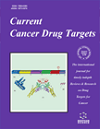- Home
- A-Z Publications
- Current Cancer Drug Targets
- Previous Issues
- Volume 3, Issue 1, 2003
Current Cancer Drug Targets - Volume 3, Issue 1, 2003
Volume 3, Issue 1, 2003
-
-
Paclitaxel Resistance: Molecular Mechanisms and Pharmacologic Manipulation
More LessAuthors: R.Z. Yusuf, Z. Duan, D.E. Lamendola, R.T. Penson and M.V. SeidenIt has been approximately ten years since the Food and Drug Administration (FDA) approved paclitaxel for the treatment of platinum resistant epithelial ovarian carcinoma. Since the approval, the drug has found therapeutic applications in a variety of schedules and in a wide variety of epithelial malignancies. Its novel mechanism of action provided the hope that it would demonstrate anti-neoplastic activity in multidrug r Read More
-
-
-
Mechanisms Controlling Sensitivity to Platinum Complexes: Role of p53 and DNA Mismatch Repair
More LessAuthors: S. Manic, L. Gatti, N. Carenini, G. Fumagalli, F. Zunino and P. PeregoAlthough cisplatin is effective in the treatment of different types of tumors, resistance to treatment is a major limitation. In an attempt of overcoming resistance mechanisms, a large effort has been made to generate compounds with a different geometry. At present, the most clinically relevant compounds include mononuclear (i.e. oxaliplatin) as well as multinuclear platinum complexes (i.e. BBR 3464). The mechanisms Read More
-
-
-
Oncogenic Signaling Pathways Activated by RON Receptor Tyrosine Kinase
More LessRON (Receptuer d'Origine Nantaise) is a member of the MET receptor tyrosine kinase family. RON is expressed in various cell types including macrophages, epithelial and hematopoietic cells. Its ligand, macrophage stimulating protein (MSP, also known as hepatocyte growth factor-like protein), is a multifunctional factor regulating cell growth and survival, adhesion and motility, cytokine production and phagocytosis. Acc Read More
-
-
-
Molecular Targets of the Oncogenic Transcription Factor Jun
More LessAuthors: M. Hartl, A.G. Bader and K. BisterThe Jun oncoprotein is a major component of the transcription factor complex AP-1, which regulates the expression of multiple genes essential for cell proliferation, differentiation and apoptosis. Constitutive activation of endogenous AP-1 is required for tumor formation in avian and mammalian cell transformation systems, and also occurs in distinct human tumor cells suggesting that AP-1 plays an important role in human oncog Read More
-
-
-
The Prodigiosins: A New Family of Anticancer Drugs
More LessAuthors: B. Montaner and R. Prez-TomsApoptosis is involved in the action of several (and perhaps all) cancer-chemotherapeutic agents. Prodigiosins, a family of natural red pigments characterized by a common pyrrolylpyrromethene skeleton, are produced by various bacteria. Three members of the prodigiosin family, viz. prodigiosin (PG), undecylprodigiosin (UP) and cycloprodigiosin hydrochloride (cPrG HCl), have immunosuppressive properties and apopto Read More
-
-
-
Garlic [Allium sativum]: A Review of its Potential Use as an Anti-Cancer Agent
More LessAuthors: M. Thomson and M. AliGarlic [Allium sativum] is among the oldest of all cultivated plants. It has been used as a medicinal agent for thousands of years. It is a remarkable plant, which has multiple beneficial effects such as antimicrobial, antithrombotic, hypolipidemic, antiarthritic, hypoglycemic and antitumor activity. In this review, we will discuss particularly the largely preclinical use of this agent in the treatment and prevention of cancer. A number of Read More
-
Volumes & issues
-
Volume 25 (2025)
-
Volume 24 (2024)
-
Volume 23 (2023)
-
Volume 22 (2022)
-
Volume 21 (2021)
-
Volume 20 (2020)
-
Volume 19 (2019)
-
Volume 18 (2018)
-
Volume 17 (2017)
-
Volume 16 (2016)
-
Volume 15 (2015)
-
Volume 14 (2014)
-
Volume 13 (2013)
-
Volume 12 (2012)
-
Volume 11 (2011)
-
Volume 10 (2010)
-
Volume 9 (2009)
-
Volume 8 (2008)
-
Volume 7 (2007)
-
Volume 6 (2006)
-
Volume 5 (2005)
-
Volume 4 (2004)
-
Volume 3 (2003)
-
Volume 2 (2002)
-
Volume 1 (2001)
Most Read This Month
Article
content/journals/ccdt
Journal
10
5
false
en


